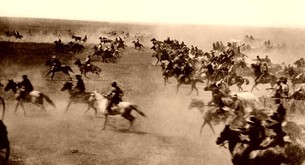The Oklahoma Land Run of 1889

The Oklahoma Land Rush of 1889 was the first land run into the Unassigned Lands and included many counties of what is now the state of Oklahoma. The land run started at high noon on April 22, 1889, with an estimated 50,000 people lined up for their piece of the available two million acres.
The Unassigned Lands were considered some of the best unoccupied public land in the United States. President Benjamin Harrison opened the two million acres for settlement. Due to the Homestead Act of 1862, signed by President Abraham Lincoln, legal settlers could claim lots up to 160 acres in size. Provided a settler lived on the land and improved it, the settler could then receive the title to the land.
A number of the people who participated in the run entered the unoccupied land early and hid there until the legal time of entry to lay quick claim to some of the most choice homesteads. These people came to be identified as "Sooners". This led to hundreds of legal contests that arose and were decided first at local land offices and eventually by the U.S. Department of the Interior. Arguments included what constituted the "legal time of entry. "While some people think that the settlers who entered the territory at the legally appointed time were known as "Boomers," the term actually refers to those who campaigned for the opening of the lands, led by David L. Payne. The University of Oklahoma's fight song, "Boomer Sooner", derives from these two names.
Rapid growth By the end of the day (April 22, 1889), both Oklahoma City and Guthrie had established cities of around 10,000 people in literally half a day. As Harper's Weekly put it:
"At twelve o'clock on Monday, April 22nd, the resident population of Guthrie was nothing; before
sundown it was at least ten thousand. In that time streets had been laid out, town lots staked off,
and steps taken toward the formation of a municipal government."
Many settlers immediately started improving their new land or stood in line waiting to file their claim. Many children sold creek water to homesteaders waiting in line for five cents a cup, while other children gathered buffalo dung to provide fuel for cooking. By the second week, schools had opened and were being taught by volunteers paid by pupils' parents until regular school districts could be established. Within one month, Oklahoma City had five banks and six newspapers.
On May 2, 1890, the Organic Act was passed creating the Oklahoma Territory. This act included the Panhandle of Oklahoma within the territory. It also allowed for central governments and designated Guthrie as the territory's capital. (taken from http://en.wikipedia.org/wiki/Land_Run_of_1889 )
The Unassigned Lands were considered some of the best unoccupied public land in the United States. President Benjamin Harrison opened the two million acres for settlement. Due to the Homestead Act of 1862, signed by President Abraham Lincoln, legal settlers could claim lots up to 160 acres in size. Provided a settler lived on the land and improved it, the settler could then receive the title to the land.
A number of the people who participated in the run entered the unoccupied land early and hid there until the legal time of entry to lay quick claim to some of the most choice homesteads. These people came to be identified as "Sooners". This led to hundreds of legal contests that arose and were decided first at local land offices and eventually by the U.S. Department of the Interior. Arguments included what constituted the "legal time of entry. "While some people think that the settlers who entered the territory at the legally appointed time were known as "Boomers," the term actually refers to those who campaigned for the opening of the lands, led by David L. Payne. The University of Oklahoma's fight song, "Boomer Sooner", derives from these two names.
Rapid growth By the end of the day (April 22, 1889), both Oklahoma City and Guthrie had established cities of around 10,000 people in literally half a day. As Harper's Weekly put it:
"At twelve o'clock on Monday, April 22nd, the resident population of Guthrie was nothing; before
sundown it was at least ten thousand. In that time streets had been laid out, town lots staked off,
and steps taken toward the formation of a municipal government."
Many settlers immediately started improving their new land or stood in line waiting to file their claim. Many children sold creek water to homesteaders waiting in line for five cents a cup, while other children gathered buffalo dung to provide fuel for cooking. By the second week, schools had opened and were being taught by volunteers paid by pupils' parents until regular school districts could be established. Within one month, Oklahoma City had five banks and six newspapers.
On May 2, 1890, the Organic Act was passed creating the Oklahoma Territory. This act included the Panhandle of Oklahoma within the territory. It also allowed for central governments and designated Guthrie as the territory's capital. (taken from http://en.wikipedia.org/wiki/Land_Run_of_1889 )

